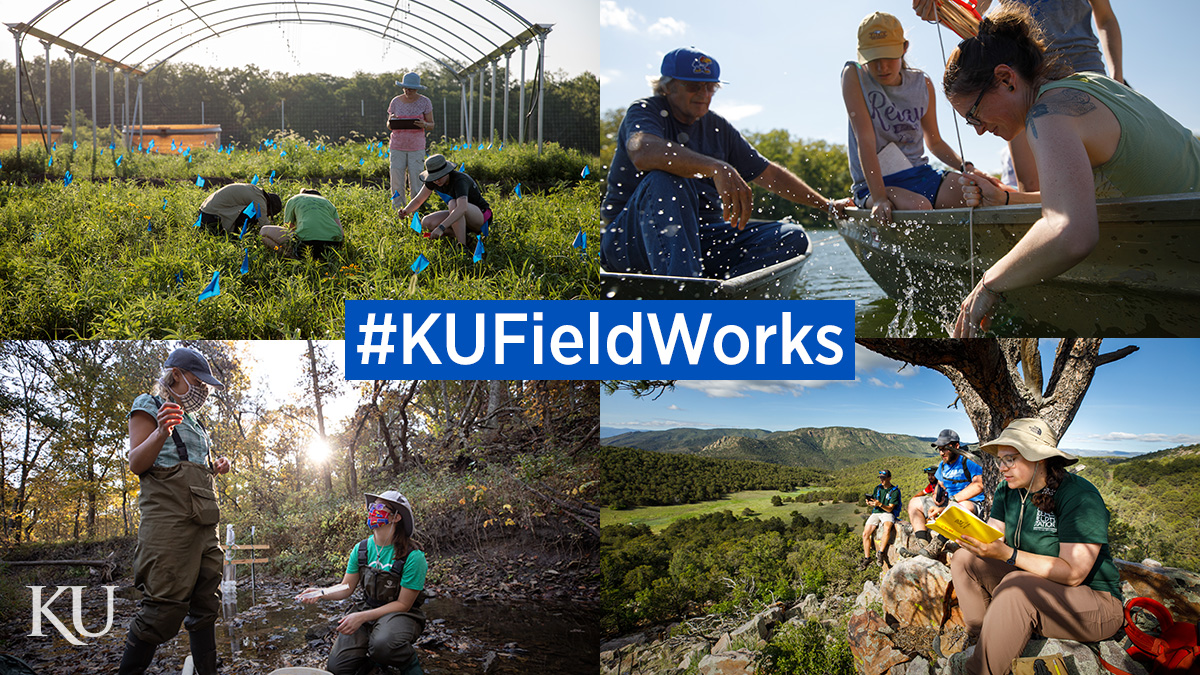#KUFieldWorks: Understanding intermittent streams and protecting water resources ‘we depend on’ in the U.S.

Editor’s note: Fieldwork provides invaluable insights about real-world environments and processes, expanding and reinforcing what researchers learn in classrooms, labs and collections. KU faculty, staff and students across a spectrum of disciplines are taking their inquiry directly to rivers, prairies, dig sites, glaciers, islands, burial grounds and more. Through the #KUFieldWorks series, we'll join them on their adventures.
Q&A with Sam Zipper, Kansas Geological Survey assistant scientist
A team of University of Kansas researchers is studying the role of intermittent streams to better understand how hydrology, biogeochemistry and microbial ecology in small headwater streams interact to influence downstream water availability and water quality.
Sam Zipper, assistant scientist at the Kansas Geological Survey, is a collaborator on the National Science Foundation-funded project, Aquatic Intermittency effects on Microbiomes in Streams (AIMS). Amy Burgin, associate professor of environmental studies and ecology & evolutionary biology and an associate scientist with the Kansas Biological Survey & Center for Ecological Research, leads the project in collaboration with eight institutions.
The team will study nine watersheds across the United States, including in Kansas, Oklahoma, Alabama and Idaho. Earlier this month, they worked at the Youngmeyer Ranch Reserve, which is a Wichita State University field station in northeast Elk County.
Zipper’s own research within the larger project focuses on how groundwater and surface water interact, such as how groundwater sustains flow in the streams above during dry periods or how the streams recharge the groundwater system. He hopes this research will illuminate how to protect water resources in the rivers we depend on.

What methods, approaches, experiments, etc. are you using?
This is a heavily field-based project including water and microbe sampling and real-time monitoring with sensors. I use a lot of distributed sensor data in my work. Across our three study watersheds in the Great Plains region, we have over 200 sensors logging every 15 minutes to tell us where the water is and what it is doing — including flow, temperature, water quality, and more. In sum, we are collecting over 20,000 new data points every day. Last week specifically, we were trying to install some monitoring wells at Youngmeyer Ranch to figure out how groundwater is behaving in the subsurface. We have a lot of stream monitoring sensors at the site but don’t have a good understanding of what the groundwater is doing away from the stream. Unfortunately, we drilled down about 350 feet and couldn’t find any water — so the mystery continues!
Why does your study matter to your field or for society?
Most of the world’s streams are non-perennial, meaning they do not flow year-round, but most of our understanding of hydrology is based on the study of perennial rivers and streams that do since these are the types of streams that society generally depends on for water supply, recreation, hydropower and more. By focusing on non-perennial streams, we will hopefully figure out how management of those upstream streams can protect water resources in the downstream rivers that we all depend on.
What do you enjoy most about conducting research in the field?
I got into Earth science because I liked to spend time outside, so it’s important to me to spend time in the field and regularly reconnect with the landscape beyond my computer screen. Even when it’s hot and windy — which it usually is in the Flint Hills in the summers in my experience — it’s great to get outside and see where the water is and is not in person and how that relates to different positions on the landscape. In addition to fieldwork, I do a lot of mathematical modeling. Regularly going outside and seeing the complexity of the real world helps me understand how to build those models and what they are still missing.
What are some memorable (funny, scary, surprising, etc.) moments from the field?
There is a very little-known imaginary holiday called National Hydroecology Burrito Day celebrated by a few random weirdos like me every April 12. We were at Youngmeyer Ranch on April 12 this year in extreme winds but still managed to celebrate with some DIY fieldwork burritos! When is fieldwork frustrating, challenging or overwhelming? I was pretty surprised and disappointed that we drilled 350 feet and couldn’t find any water. We drilled another 150 feet right next to the stream and still didn’t hit any water-bearing fractures. But that’s why we do the science — if we already knew what was down there, we wouldn’t need to drill the holes!
Top photo: University of Kansas researchers conduct fieldwork in prairies, rivers, streams and mountains. The #KUFieldWorks series follows researchers on their fieldwork adventures.
Second photo: Sam Zipper, Kansas Geological Survey assistant scientist.